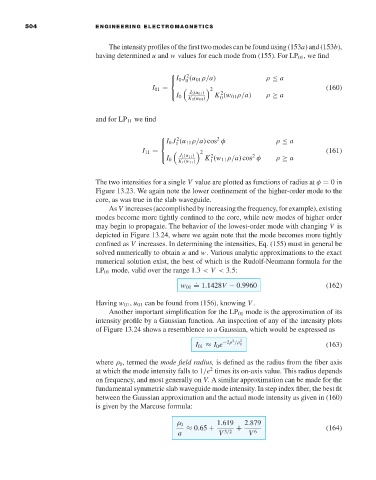Page 522 - Engineering Electromagnetics, 8th Edition
P. 522
504 ENGINEERING ELECTROMAGNETICS
The intensity profiles of the first two modes can be found using (153a) and (153b),
having determined u and w values for each mode from (155). For LP 01 ,wefind
2
I 0 J (u 01 ρ/a) ρ ≤ a
0
I 01 = 2 (160)
J 0 (u 01 ) 2
I 0 K 0 (w 01 ) 0
K (w 01 ρ/a) ρ ≥ a
and for LP 11 we find
2 2
I 0 J (u 11 ρ/a) cos φ ρ ≤ a
1
I 11 = 2 (161)
J 1 (u 11 ) 2 2
I 0
K (w 11 ρ/a) cos φ ρ ≥ a
K 1 (w 11 ) 1
The two intensities for a single V value are plotted as functions of radius at φ = 0in
Figure 13.23. We again note the lower confinement of the higher-order mode to the
core, as was true in the slab waveguide.
As V increases (accomplished by increasing the frequency, for example), existing
modes become more tightly confined to the core, while new modes of higher order
may begin to propagate. The behavior of the lowest-order mode with changing V is
depicted in Figure 13.24, where we again note that the mode becomes more tightly
confined as V increases. In determining the intensities, Eq. (155) must in general be
solved numerically to obtain u and w.Various analytic approximations to the exact
numerical solution exist, the best of which is the Rudolf-Neumann formula for the
LP 01 mode, valid over the range 1.3 < V < 3.5:
.
w 01 = 1.1428V − 0.9960 (162)
Having w 01 , u 01 can be found from (156), knowing V .
Another important simplification for the LP 01 mode is the approximation of its
intensity profile by a Gaussian function. An inspection of any of the intensity plots
of Figure 13.24 shows a resemblence to a Gaussian, which would be expressed as
2
I 01 ≈ I 0 e −2ρ /ρ 0 2 (163)
where ρ 0 , termed the mode field radius, is defined as the radius from the fiber axis
2
at which the mode intensity falls to 1/e times its on-axis value. This radius depends
on frequency, and most generally on V.A similar approximation can be made for the
fundamental symmetric slab waveguide mode intensity. In step index fiber, the best fit
between the Gaussian approximation and the actual mode intensity as given in (160)
is given by the Marcuse formula:
ρ 0 1.619 2.879
≈ 0.65 + + (164)
a V 3/2 V 6

